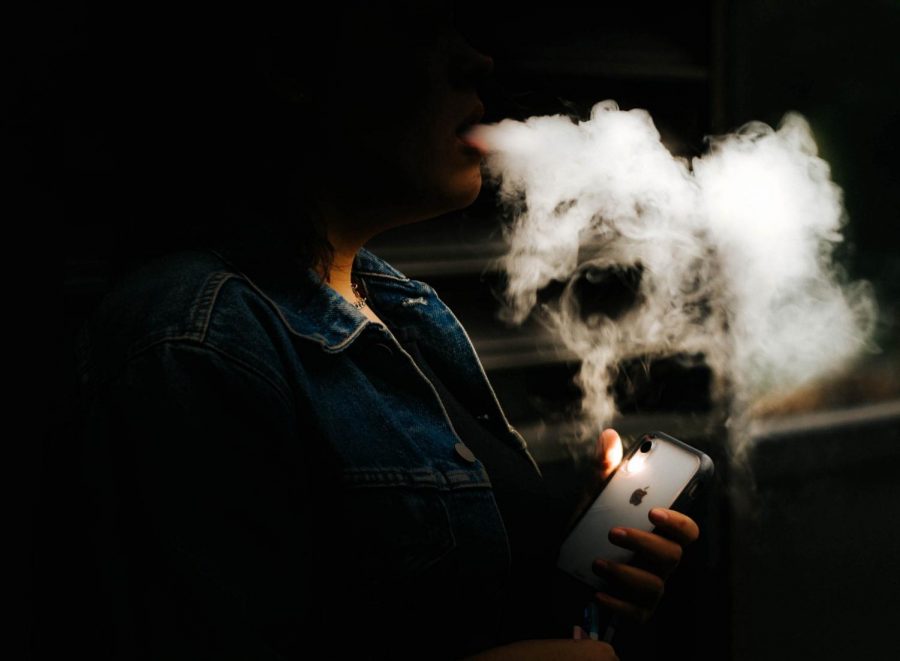Cut off and addicted
When Community High School (CHS) senior, Jamie Wells* started vaping the summer before her sophomore year, she had no idea what she was getting into. She became addicted quickly, constantly wanting to hit her Suorin Air, craving the buzz.
Wells realized she was addicted in the middle of her sophomore year but did not attempt to quit until more recently. Wells and a group of her friends have been trying to quit for four months — and it is not going well.
“We have been failing, epically failing,” Wells said.
Wells has been using a JUUL since her junior year, so when she decided to quit she started by switching back to a Suorin. The difference between Juul and Suorin is with Suorins you can control the amount of nicotine in vape juice. By quitting JUUL, Wells was able to lower her nicotine intake. Eventually, she lowered the amount of nicotine in her Suorin to the lowest she could get, she was barely getting a buzz from it anymore and was using it out of habit rather than necessity.
After trying to quit for four months, Wells was finally able to throw away her Suorin. But her nicotine addiction is still affecting her.
“Anytime I’m with people who have JUUL I’m like, ‘Can I hit it? Can I hit it?’” Wells said.
Clara Lewis* is a sophomore at CHS who also experienced addiction during her freshman year. She realized the severity of her addiction when her older sister noticed that her mood had become dependent on her access to nicotine. She was also vaping constantly, leaving class every 15 minutes to go to the bathroom.
“I had the constant urge to just do it, and going through hockey practice without it was really hard, even though it’s only an hour and 20 minutes,” Lewis said.
Lewis’ addiction was also affecting her ability to spend time with her family. She would choose staying home and vaping over taking opportunities to spend time with her family; she felt like she could only have fun and be happy if she had her JUUL.
According to Robbie Stapleton, health and fitness teacher at CHS, signs of addiction can include loss of control, high tolerance, abuse of the substance, and withdrawal. These signs can manifest in different ways: vaping once a day to vaping every hour, mood swings, irritability, continuing to use it even with negative consequences, wanting to quit but being unable to.
Nicotine addiction is different than other addictions because of how easily accessible it is; JUULS are easily used in public settings because they are small, odorless and discrete. Additionally, it is different because nicotine is a stimulant, so when you first start using it you get a rush of dopamine in your brain — a “buzz.”
According to Stapleton, nicotine itself is as addictive as alcohol but less addictive than amphetamines, cocaine or adderall. Because nicotine is so easy to work into daily life, it is much easier to use constantly. Once the brain realizes that dopamine is being provided from an external source it stops producing it, causing dopamine levels to decrease. When this happens the brain experiences a need to have nicotine to feel normal and relaxed.
One other thing that makes teenagers so susceptible to vaping — apart from how easily accessible it is — is that teenage brains are much more likely to experience addiction than adult brains.
“That’s why we call addiction the disease of adolescence.” Stapleton said. “Someone who starts vaping, smoking, doing weed before they’re 15 has a five times greater chance to develop addiction or problems with that drug.”
On Sept. 18, 2019, Gretchen Whitmer issued emergency rules banning the sale of flavored vape juice in Michigan. The ban is in effect for six months, at which point it could be renewed.
“ [The ban] sent a lot of people into a panic,” Wells said. “People were like ‘how the hell and where am I going to get [nicotine].’”
Wells thinks some will just turn to tobacco JUUL pods or even cigarettes if they don’t have access to the fruity pod flavors they’re used to.
Both Wells and Stapleton agree that this ban could cause teens to buy vape juice from black markets, or turn to smoking cigarettes instead of vaping.
According to the Department of Health and Human Services, the amount of high school students smoking cigarettes has dramatically decreased in the past 40 years. In 1976, 28.8 percent of high school seniors reported smoking every day, in 2018 that number had gone down to 3.6 percent.
“We have gotten it now where around 4 percent of high school kids smoke cigarettes. From when I was in high school that is a huge decline,” Stapleton said. “It’s one of the most monumental successes ever in the history of public health.”
Lewis had been trying to quit vaping for a few months when she was caught by her mom. She got her vape taken away and did not get another one. She saw getting caught as a good sign, something that would help her quit entirely. She used the fact that her mom already knew she had been vaping to her advantage, talking to her when she felt like she needed nicotine.
There are resources to aid teens in quitting nicotine. One such resource, a free digital quitting program, was created by truthinitiative.org. People trying to quit can sign up for help through text messages, and throughout the day Truth Initiative will send inspiring, supportive messages and coping strategies. Wells liked the messages, they were reminders that she was strong enough to quit.
Lewis’ advice to those trying to quit is this: “To people who need help quitting: just tell someone, you can’t do it alone.”
*names have been changed to protect anonymity









